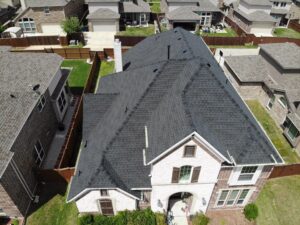Texas is known for its unpredictable and often extreme weather conditions. From blistering summer heat to severe thunderstorms and the occasional hailstorm, the state’s weather can take a serious toll on your roof. As a homeowner, it’s essential to understand how Texas weather impacts your roof and what steps you can take to protect it. A well-maintained roof will not only safeguard your home but also increase its lifespan.
Let’s dive into how various weather patterns affect your roof in Texas and share some expert tips on how to protect your roof from the harsh elements.
1. Intense Heat and UV Exposure
How It Affects Your Roof
Texas summers are notorious for their scorching temperatures, with average highs often exceeding 100°F. Prolonged exposure to intense heat and ultraviolet (UV) rays can cause significant wear and tear on your roof.
- Shingle Deterioration: Asphalt shingles, one of the most common roofing materials in Texas, can become brittle and start to crack or curl under the constant exposure to the sun’s UV rays.
- Fading and Discoloration: Over time, the intense heat can cause roofing materials to lose their color and appearance. This not only reduces curb appeal but also shortens the lifespan of your roof.
How to Protect Your Roof
- Opt for Reflective Roofing Materials: Choose materials with reflective properties, such as cool roofing or metal roofs, which help reduce heat buildup in the attic.
- Regular Maintenance: Regular roof inspections and cleaning can help identify any signs of damage, such as cracked or curling shingles, before they become major issues.
- Install Attic Ventilation: Proper attic ventilation helps reduce heat buildup, preventing your roof from overheating and ensuring a more energy-efficient home.
2. Heavy Rain and Flooding
How It Affects Your Roof
Texas is no stranger to heavy rainfall, particularly during hurricane season and spring thunderstorms. While your roof is designed to shed water, consistent heavy rains can lead to water damage and leaks if your roof is not properly maintained.
- Leaking Roofs: Even minor damage to shingles or flashing can allow water to penetrate your roof, leading to leaks, water stains, and mold growth inside your home.
- Gutter Clogs: The combination of heavy rain and falling debris, such as leaves and branches, can cause gutters to clog, preventing water from draining properly. This can lead to water pooling around the roof, increasing the risk of leaks.
How to Protect Your Roof
- Regular Gutter Cleaning: Clean your gutters regularly, especially after a storm, to ensure proper water drainage and prevent water buildup.
- Check Flashing and Seals: Inspect the flashing around chimneys, vents, and skylights to ensure it’s properly sealed. Damaged flashing can lead to leaks during heavy rain.
- Professional Inspections: Schedule annual roof inspections to check for any signs of water damage or wear, including cracks in shingles and damaged flashing.
3. Hailstorms
How It Affects Your Roof
Hail is a common weather phenomenon in Texas, especially in the spring and early summer months. Even small hailstones can cause significant damage to your roof, as the impact can crack, dent, or dislodge shingles. Large hail can result in more severe damage, including puncturing or tearing through roofing materials.
- Shingle Damage: Hailstones can create visible damage, including cracks, dents, and bruising, which can lead to leaks over time.
- Granule Loss: Asphalt shingles are coated with small granules that help protect them from UV rays and provide a textured surface for water runoff. Hail impact can cause these granules to dislodge, weakening the shingles and reducing their effectiveness.
How to Protect Your Roof
- Impact-Resistant Roofing Materials: Consider upgrading to impact-resistant shingles or metal roofing, which are designed to withstand hail damage better than traditional asphalt shingles.
- Hail Storm Preparedness: If a hailstorm is expected, take precautionary measures like covering skylights or windows with plywood or tarps to minimize damage.
- Roof Inspections After a Storm: After a hailstorm, schedule a professional roof inspection to assess any damage and address it quickly to avoid long-term issues.
4. Strong Winds
How It Affects Your Roof
Texas is no stranger to high winds, especially during spring and fall storm seasons. Severe storms, tornadoes, and hurricanes can bring wind gusts strong enough to lift shingles and cause extensive damage.
- Shingle Lift and Blow-off: High winds can tear shingles off your roof, exposing the underlying materials and leaving your home vulnerable to leaks.
- Tree Damage: Windstorms can cause branches or even entire trees to fall on your roof, causing significant damage.
How to Protect Your Roof
- Wind-Resistant Roofing: Choose roofing materials that are designed to withstand high winds, such as metal roofing, which is known for its durability in wind-prone areas.
- Trim Trees and Remove Debris: Regularly trim any overhanging branches that could fall on your roof during a storm. Also, clear away debris and leaves to prevent them from clogging gutters.
- Proper Installation: Ensure that your roof is installed according to local building codes that take wind speed into account. Proper installation of shingles, flashing, and underlayment is crucial for wind resistance.
5. Winter Freeze and Ice Dams
How It Affects Your Roof
Although Texas doesn’t experience extreme winter conditions as often as northern states, freezing temperatures and occasional snow or ice storms can still cause roof damage. When snow or ice melts during the day and refreezes at night, it can cause ice dams along the eaves of the roof. These ice dams prevent proper drainage, causing water to back up under shingles and leading to leaks and water damage inside the home.
How to Protect Your Roof
- Improve Insulation: Proper attic insulation helps prevent heat from escaping and melting snow, which reduces the likelihood of ice dams forming.
- Install Proper Ventilation: Ensure your roof has adequate ventilation to allow warm air to escape, preventing the formation of ice dams and ensuring that snow melts evenly.
How Trophy Roofing and Construction Can Help
At Trophy Roofing and Construction, we understand the unique challenges that Texas weather poses to your roof. Our expert roofing team can help you protect your roof from the elements, whether through regular maintenance, roof repairs, or complete replacements.
We offer:
- Free Roof Inspections: Our team will assess the condition of your roof and recommend the best steps to protect it from Texas weather.
- Storm Damage Repairs: If your roof has suffered damage from a storm, we can provide fast, reliable repairs to restore its integrity.
- Energy-Efficient Roofing: We offer roofing solutions that can help reduce your energy costs while keeping your home safe from the elements.
- Roof Replacement and Installation: If your roof has reached the end of its lifespan or sustained severe damage, we provide expert roof replacement services using high-quality materials designed to withstand Texas weather.
Contact Us for a Roof Inspection
Don’t wait until your roof suffers from severe damage. Contact Trophy Roofing and Construction today for a professional roof inspection and to learn how you can protect your roof from Texas weather. Our experienced team is here to help you ensure your roof is in top condition, no matter what the weather throws your way.



